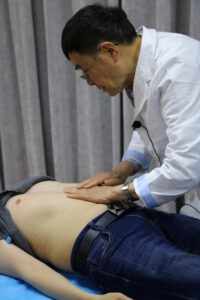The Jingfang Case Studies and Medical Treatises of Dr. Lou Shao-kun

The following case study comes from The Jingfang Case Studies and Medical Treatises of Dr. Lou Shao-kun by Lou Shenshan, translated by Will Ceurvels, scheduled to be released by Purple Cloud Institute in the next couple months.
In this volume, Dr. Lou Shao-kun, a formidable clinician and intellect regarded as one of the twentieth century’s premier practitioners and scholars of jīngfāng herbalism, takes you step by step through his clinical process in this collection of over 70 case studies and his large corpus of medical essays.
Infertility with Amenorrhea Treated with Wen Jing Tang (JuéYīn Type)
Ms. Zhang, 32 years
First Visit: February 10th, 1984
History: The patient has failed to conceive in five years of marriage. Her menarche came at 18 years old and has subsequently had delayed menstruation, with periods only coming every three-four months. In the past eight months, she has developed amenorrhea, which Western medicine diagnosed as secondary amenorrhea (though the primary cause remained unclear). She was found to have a monophasic basal temperature.
Current: The patient has a pale, dark complexion and complains of pain and cold in the lower abdomen, aversion to cold, cold limbs, dry lips, dry cracked palms, cold hands and feet, sloppy stools, and copious, transparent leukorrhea.
Pulse: Sunken and tight
Tongue: Dark and pale with a thick, white, greasy coating.
Abdominal Palpation: Fullness and distention in the lower abdomen that is soft and lacks springiness. No binds can be palpated.
Channel Palpation: Pain upon pressing DU2.
Diagnosis: Juéyīn disease, liver channel qì and blood stagnation, and yáng qì vacuity diffusion.
Formula: Wen Jing Tang
Dang Gui 10g, Ban Xia 10g, Mai Dong 1og, Dang Shen 15g, E Jiao 10g (Dissolved), Mu Dan Pi 6g, Chuan Xiong 6g, Gui Zhi 6g, Gan Cao 2g, Wu Zhu Yu 1.5g, Gan Jiang 3g.
Additionally, I wet cupped at DU2 every second week.
After fifty days of treatment, she developed a biphasic basal body temperature and showed signs of ovulation. She continued taking this formula and getting wet cupping, and ultimately conceived successfully in June of 1984.
Clinical Insight
Intermingling of yīn and yáng, co-dependent growth and decline of yīn and yáng, and counterflow and normalization of yīn and yáng are the three principal characteristics of Juéyīn disease. Additionally, Juéyīn disease also often involves dysfunction of the coursing of liver qì and related blood disorders. The fact that the major Juéyīn formulas Dang Gui Si Ni Tang and Dang Gui Si Ni plus Wu Zhu Yu, Sheng Jiang Tang both feature Dang Gui in their names demonstrates the role of blood disorders in Juéyīn.
Wen Jing Tang can be seen as a modification of Dang Gui Si Ni Tang plus Wu Zhu Yu, Sheng Jiang. The formula appears in the “Miscellaneous Gynecological Diseases” chapter of the Essential Prescriptions of the Golden Chamber where it is indicated for “Urgency in the lower abdomen, abdominal fullness, heat vexation in the palms, dry lips and dry mouth…it also is indicated for coldness in the lower abdomen with infertility or advanced menstruation”. Zhong-jing’s classic blood nourishing and channel warming formula is marked by an abdominal presentation featuring coldness in the lower abdomen, lower abdominal distention and fullness, lack of springiness, and lack of binds or masses. The patient’s presentation matched the formula pattern, so naturally it was effective in treating her infertility.
In amenorrhea, one can often find sensitive spots in the lumbosacral region and especially at DU2, DU3, and below the 5th lumbar vertebrae at EX-B8 (what the Japanese call “The High Immortal Point”). Wet cupping at these points will greatly improve the efficaciousness of treatment.
Menstruation is closely linked with the liver’s blood-storing and coursing functions. It is Juéyīn that chiefly presides over this dynamic of storing and coursing, inbearing and outbearing. If vacuity cold is generated within and ice lodges in the sea of blood, infertility, and transparent cold leukorrhea often result. Thus, the Jin Dynasty physician Liu Wan-su (劉完素) stated: “The flow of tiānguǐ water should be understood in terms of Juéyīn function.”
Coverart: Jen King
Would you like to subscribe to our newsletter?
If you enjoyed reading this please consider supporting us!
When we started the Purple Cloud Institute, our aim was to make accessible educational material about traditional Chinese cultural practices. We strive to keep prices of our books as affordable as possible and the content we provide free of charge. However, there are many ongoing behind the scenes costs and the time taken to provide such content is considerable.
If you have enjoyed our offerings please consider donating and supporting us. The help will allow us to make time to bring you more in the way of book publications, podcasts and videos about tradition-based Daoist, Chinese medicine and martial arts and help keep these traditions alive.
Your assistance is greatly appreciated!
